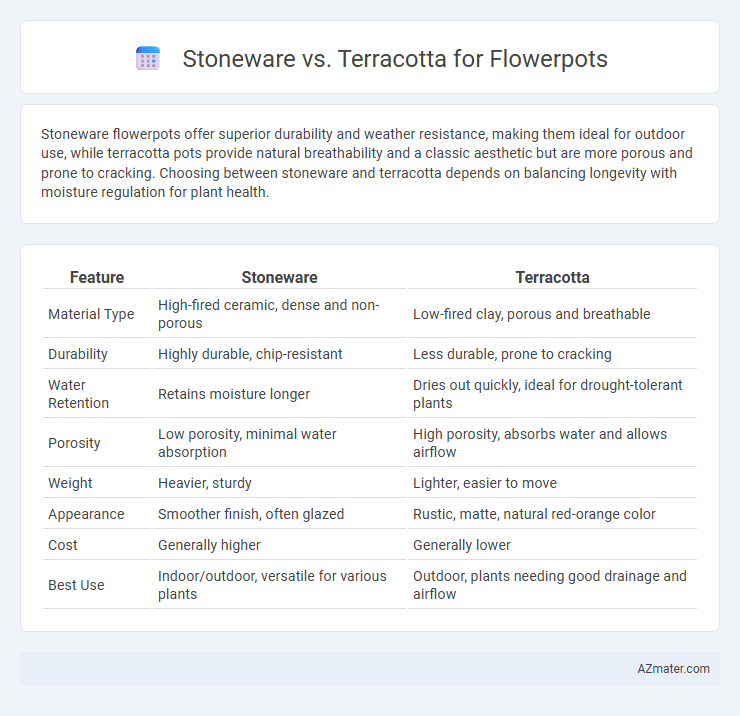Stoneware flowerpots offer superior durability and weather resistance, making them ideal for outdoor use, while terracotta pots provide natural breathability and a classic aesthetic but are more porous and prone to cracking. Choosing between stoneware and terracotta depends on balancing longevity with moisture regulation for plant health.
Table of Comparison
| Feature | Stoneware | Terracotta |
|---|---|---|
| Material Type | High-fired ceramic, dense and non-porous | Low-fired clay, porous and breathable |
| Durability | Highly durable, chip-resistant | Less durable, prone to cracking |
| Water Retention | Retains moisture longer | Dries out quickly, ideal for drought-tolerant plants |
| Porosity | Low porosity, minimal water absorption | High porosity, absorbs water and allows airflow |
| Weight | Heavier, sturdy | Lighter, easier to move |
| Appearance | Smoother finish, often glazed | Rustic, matte, natural red-orange color |
| Cost | Generally higher | Generally lower |
| Best Use | Indoor/outdoor, versatile for various plants | Outdoor, plants needing good drainage and airflow |
Overview: Stoneware vs Terracotta Flowerpots
Stoneware flowerpots offer durability and resistance to chipping due to their dense, non-porous nature, making them ideal for outdoor use and retaining moisture longer. Terracotta flowerpots are natural, porous clay vessels that allow air and water to pass through, promoting healthy root aeration but requiring more frequent watering. Choosing between stoneware and terracotta depends on factors like plant type, watering needs, and aesthetic preferences, as each material provides distinct benefits for gardening success.
Material Composition and Properties
Stoneware flowerpots are made from dense, non-porous clay fired at high temperatures, resulting in a durable, waterproof material resistant to cracking and weathering. Terracotta pots consist of porous, low-fired clay that allows excellent breathability and moisture evaporation, promoting healthy root growth but requiring more frequent watering. The inherent thermal insulation of stoneware helps stabilize soil temperature, while terracotta's porous nature enhances aeration but may deteriorate faster in harsh climates.
Porosity and Breathability
Stoneware flowerpots exhibit low porosity due to their dense, vitrified clay composition, which limits water absorption and retains moisture longer, making them ideal for plants requiring consistent hydration. In contrast, terracotta pots have high porosity, allowing air and moisture to pass through the walls, improving soil aeration and preventing root rot but necessitating more frequent watering. The breathability of terracotta supports healthier root systems in drying soils, while stoneware's reduced permeability suits moisture-loving plants or indoor environments.
Durability and Longevity
Stoneware flowerpots offer superior durability and longevity compared to terracotta due to their dense, non-porous composition that resists cracking and weathering. Terracotta pots, while breathable and lightweight, are more prone to chipping and breaking, especially in freezing temperatures or prolonged moisture exposure. Choosing stoneware ensures a longer-lasting container ideal for outdoor and harsh climate conditions.
Weight and Handling
Stoneware flowerpots are heavier and more durable, providing stability for larger plants but requiring more effort to move and handle. Terracotta pots are lighter and easier to handle, making them ideal for frequent repositioning or indoor use, though they are more prone to chipping and cracking. The choice between stoneware and terracotta depends on balancing weight for stability versus ease of handling for portability.
Water Retention and Drainage
Stoneware flowerpots offer superior water retention due to their dense, non-porous structure, minimizing moisture loss and supporting consistent soil hydration. Terracotta pots are porous, allowing excess water to evaporate quickly, which enhances drainage but requires more frequent watering. Gardeners seeking balanced moisture control often choose stoneware for water retention and terracotta for plants prone to root rot.
Aesthetic Appeal and Finishes
Stoneware flowerpots offer a smooth, polished finish with rich, earthy tones that enhance garden aesthetics through their refined, sophisticated look. Terracotta pots feature a natural, porous texture with warm, rustic hues that develop a weathered charm over time, adding character to any plant display. The choice between stoneware's sleek durability and terracotta's classic, organic appeal depends on the desired decorative style and maintenance preferences.
Suitability for Indoor and Outdoor Use
Stoneware flowerpots offer superior durability and water resistance, making them highly suitable for both indoor and outdoor use, especially in varying weather conditions. Terracotta pots are porous and allow better airflow to plant roots, ideal for indoor plants or outdoor use in dry climates but may crack in freezing temperatures. Choosing between stoneware and terracotta depends on the specific environment, with stoneware favored for harsh outdoor elements and terracotta preferred for breathability and aesthetic warmth indoors.
Cost Comparison
Stoneware flowerpots generally cost more than terracotta due to their durable, vitrified composition and resistance to weathering, making them a long-term investment for gardeners. Terracotta pots are more affordable upfront, crafted from porous clay that provides excellent breathability for plants but may require frequent replacement due to fragility and susceptibility to cracking. Buyers prioritizing budget-friendly options typically choose terracotta, while those seeking longevity and low maintenance often prefer the higher-priced stoneware.
Choosing the Right Pot for Your Plants
Stoneware flowerpots offer superior durability and moisture retention, making them ideal for plants that require consistent hydration, while terracotta pots provide excellent breathability and natural heat regulation, benefiting plants that prefer drier conditions. Terracotta's porous nature helps prevent root rot by allowing excess water to evaporate, whereas stoneware resists cracking and weathering, suitable for both indoor and outdoor use. Selecting the right pot depends on plant species' watering needs and environmental exposure, ensuring optimal growth and health.

Infographic: Stoneware vs Terracotta for Flowerpot
 azmater.com
azmater.com